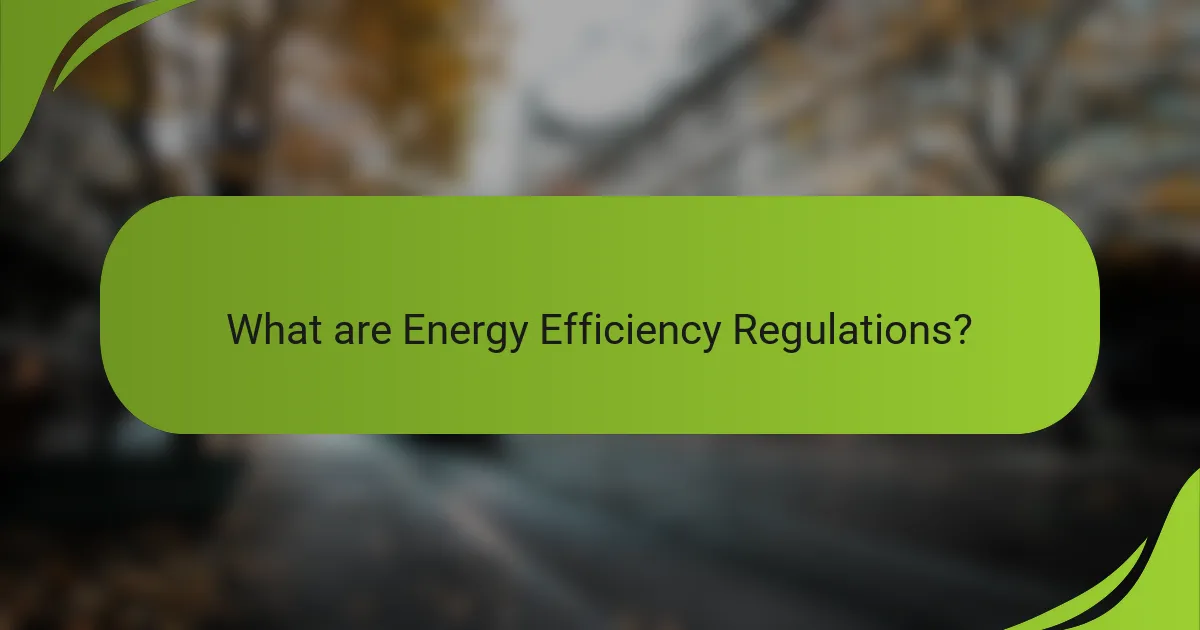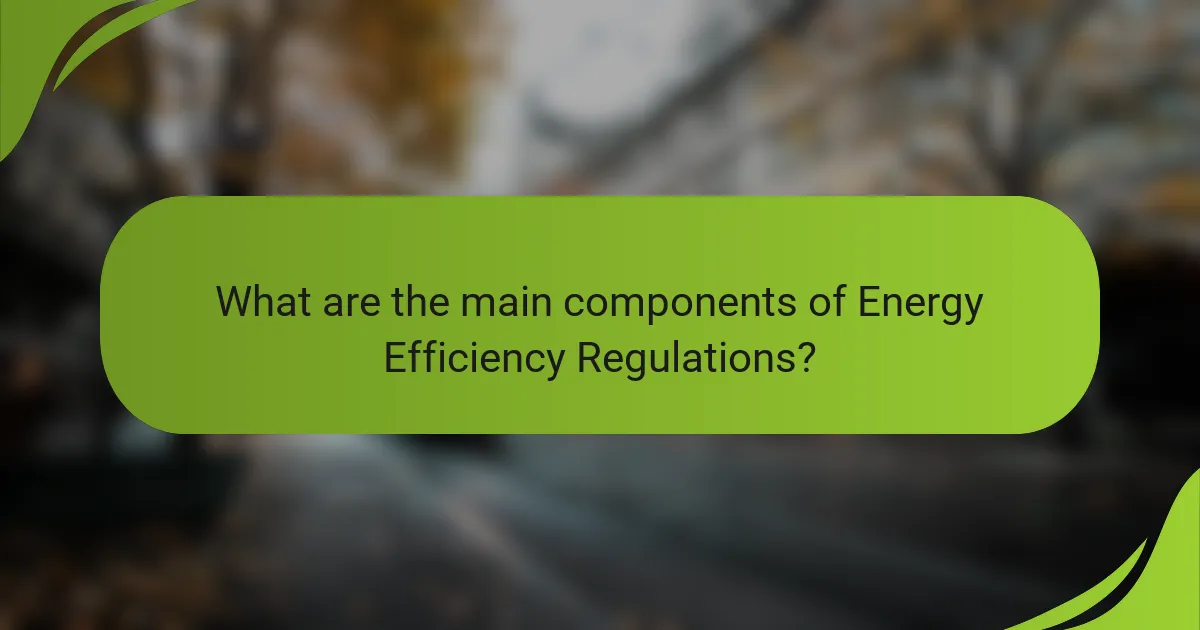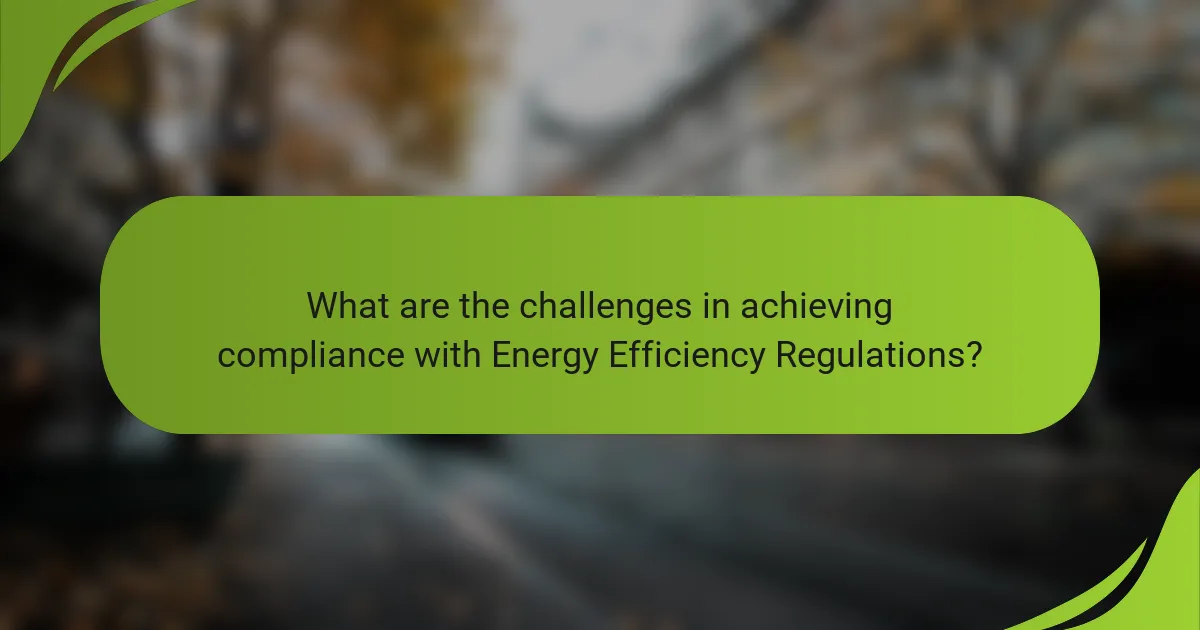Energy efficiency regulations are legal standards designed to reduce energy consumption across various sectors, including appliances, buildings, and industrial processes. These regulations establish minimum energy performance levels to promote sustainability and lower greenhouse gas emissions. Key components include standards that define performance requirements, labeling that informs consumers about energy efficiency, and compliance mechanisms that ensure adherence through inspections and penalties. Challenges in achieving compliance include the complexity of regulations, financial constraints, lack of awareness among stakeholders, and the resource-intensive nature of tracking energy usage. Understanding these regulations is essential for promoting sustainable architecture and effective resource conservation.

What are Energy Efficiency Regulations?
Energy efficiency regulations are legal standards aimed at reducing energy consumption. These regulations often apply to appliances, buildings, and industrial processes. They mandate minimum energy performance levels to promote sustainability. For example, the U.S. Department of Energy sets energy efficiency standards for appliances. Compliance with these regulations helps lower greenhouse gas emissions. Studies show that adhering to energy efficiency regulations can significantly reduce energy costs for consumers. Overall, energy efficiency regulations play a crucial role in environmental protection and resource conservation.
How do Energy Efficiency Regulations impact sustainable architecture?
Energy efficiency regulations significantly influence sustainable architecture by setting standards for energy consumption and building performance. These regulations ensure that new constructions minimize energy use, thereby reducing greenhouse gas emissions. Compliance with these regulations often leads to the adoption of advanced materials and technologies. For example, buildings may incorporate better insulation, energy-efficient windows, and renewable energy sources. Studies show that buildings designed under strict energy efficiency guidelines can reduce energy use by up to 30%. Additionally, such regulations promote the use of sustainable practices in design and construction. This shift not only enhances environmental sustainability but also improves long-term economic viability for property owners.
What are the key objectives of Energy Efficiency Regulations?
The key objectives of Energy Efficiency Regulations are to reduce energy consumption and lower greenhouse gas emissions. These regulations aim to promote sustainable practices in energy use. They encourage the adoption of energy-efficient technologies and building designs. Energy Efficiency Regulations also seek to enhance economic savings for consumers and businesses through reduced energy bills. Additionally, these regulations improve energy security by decreasing reliance on fossil fuels. They contribute to environmental protection by minimizing the ecological impact of energy production. Overall, the objectives align with global efforts to combat climate change and promote sustainability.
How do these regulations vary by region or country?
Energy efficiency regulations vary significantly by region and country. In the European Union, regulations are stringent, with directives aimed at reducing energy consumption in buildings. For instance, the Energy Performance of Buildings Directive mandates energy performance certificates for new constructions. In the United States, regulations differ by state; California enforces stricter energy codes compared to other states. In Australia, the National Construction Code sets energy efficiency requirements, but states can impose additional standards. Developing countries may have less comprehensive regulations, focusing on basic energy efficiency measures. These differences reflect local energy needs, economic conditions, and environmental goals.
Why is compliance with Energy Efficiency Regulations important?
Compliance with Energy Efficiency Regulations is crucial for reducing energy consumption and environmental impact. These regulations promote sustainable practices in architecture and construction. By adhering to these standards, buildings can significantly lower greenhouse gas emissions. According to the U.S. Department of Energy, energy-efficient buildings can reduce energy use by 30% to 50%. This not only benefits the environment but also leads to cost savings for building owners and occupants. Furthermore, compliance with these regulations can enhance a building’s marketability and value. Studies show that energy-efficient buildings often attract higher rental rates and occupancy levels. Therefore, compliance is essential for economic, environmental, and social sustainability.
What are the potential consequences of non-compliance?
Non-compliance with energy efficiency regulations can lead to significant financial penalties. Organizations may face fines that can reach tens of thousands of dollars. Non-compliance can also result in increased operational costs due to inefficient energy use. Buildings that do not meet standards may incur higher utility bills. Additionally, non-compliance can damage an organization’s reputation. Stakeholders may lose trust in companies that fail to adhere to regulations. Legal repercussions can also arise, including lawsuits or enforcement actions from regulatory bodies. Ultimately, non-compliance undermines efforts toward sustainable architecture and environmental responsibility.
How can compliance enhance the sustainability of architectural projects?
Compliance with energy efficiency regulations enhances the sustainability of architectural projects by ensuring that buildings meet established environmental standards. These regulations often mandate the use of sustainable materials and energy-efficient systems. Adhering to these standards reduces energy consumption and greenhouse gas emissions. For instance, buildings that comply with LEED certification can achieve up to 30% lower energy costs. Compliance also fosters innovation in sustainable design practices. Architects are encouraged to integrate renewable energy sources, such as solar panels, into their designs. This can lead to long-term operational savings and improved occupant comfort. Furthermore, compliance can enhance a project’s marketability and value, attracting environmentally conscious buyers and tenants. Overall, compliance drives the architectural industry towards more sustainable practices and outcomes.

What are the main components of Energy Efficiency Regulations?
The main components of Energy Efficiency Regulations include standards, labeling, and compliance mechanisms. Standards define the minimum energy performance requirements for buildings and appliances. Labeling provides consumers with information about energy consumption and efficiency ratings. Compliance mechanisms ensure adherence to regulations through inspections and penalties. These components work together to promote energy conservation and reduce greenhouse gas emissions. For instance, the U.S. Department of Energy sets appliance efficiency standards that have saved consumers billions in energy costs.
What types of standards are included in Energy Efficiency Regulations?
Energy Efficiency Regulations include several types of standards. These standards encompass performance standards, which specify energy efficiency levels for products and systems. They also include labeling standards that require clear information on energy consumption. Additionally, there are building codes that mandate energy-efficient design and construction practices. Testing standards ensure that products meet energy efficiency claims. Compliance standards outline the procedures for verifying adherence to regulations. Finally, there are guidelines for energy management systems that promote ongoing efficiency improvements. These standards collectively aim to reduce energy consumption and promote sustainable practices.
How do performance-based standards differ from prescriptive standards?
Performance-based standards focus on achieving specific outcomes or performance levels, while prescriptive standards dictate specific methods or practices to achieve compliance. Performance-based standards allow for flexibility in how to meet the required outcomes. For example, a performance-based standard may require a building to achieve a certain energy efficiency rating, but it does not specify how to achieve that rating. In contrast, prescriptive standards would outline exact materials, construction techniques, or technologies to use. The flexibility of performance-based standards can encourage innovation, as designers can choose the most effective methods for their specific projects. On the other hand, prescriptive standards provide clear guidelines, which can simplify compliance but may limit creativity and adaptability.
What role do labeling and certification play in these regulations?
Labeling and certification are critical components of energy efficiency regulations. They provide standardized information about a product’s energy performance. Labels help consumers make informed choices by displaying energy usage data. Certifications ensure that products meet specific energy efficiency standards. Regulatory bodies often require these labels and certifications to promote compliance. This process enhances transparency in the marketplace. For example, the ENERGY STAR label signifies that a product meets high efficiency criteria set by the EPA. By fostering accountability, labeling and certification support the overall goals of sustainability in architecture.
How are Energy Efficiency Regulations enforced?
Energy efficiency regulations are enforced through a combination of governmental oversight, compliance audits, and penalties for non-compliance. Regulatory agencies, such as the Department of Energy in the U.S., establish standards for energy performance. These agencies conduct inspections and audits to verify compliance with these standards. Non-compliant entities may face fines or other legal actions. In addition, states may implement their own enforcement mechanisms to ensure adherence to local regulations. Industry stakeholders are often required to report energy usage data to demonstrate compliance. The enforcement process aims to promote energy conservation and reduce environmental impact.
What agencies are responsible for enforcing compliance?
The agencies responsible for enforcing compliance with energy efficiency regulations include the U.S. Department of Energy (DOE) and the Environmental Protection Agency (EPA). The DOE oversees the implementation of energy efficiency standards for appliances and equipment. The EPA enforces regulations related to energy use and environmental impact. Additionally, state and local agencies may also enforce compliance within their jurisdictions. These agencies ensure adherence to regulations that promote sustainable architecture. Their enforcement actions can include inspections, fines, and penalties for non-compliance.
What are the common methods of monitoring and evaluation?
Common methods of monitoring and evaluation include surveys, performance indicators, and case studies. Surveys collect data directly from stakeholders to assess satisfaction and outcomes. Performance indicators provide measurable values to track progress against goals. Case studies offer in-depth analysis of specific instances to illustrate effectiveness. These methods are widely used in various sectors, including sustainable architecture, to ensure compliance with energy efficiency regulations. Each method provides unique insights that contribute to a comprehensive understanding of project performance.

What are the challenges in achieving compliance with Energy Efficiency Regulations?
Achieving compliance with Energy Efficiency Regulations presents several challenges. One major challenge is the complexity of the regulations themselves. These regulations often involve detailed technical specifications and requirements that can be difficult to interpret. Another challenge is the financial burden associated with implementing energy-efficient solutions. Many organizations may lack the necessary funds to upgrade their systems or technologies. Additionally, there is often a lack of awareness or understanding of the regulations among stakeholders. This can lead to non-compliance due to ignorance rather than willful neglect. Furthermore, tracking and reporting energy usage to demonstrate compliance can be resource-intensive. Organizations may struggle to collect accurate data or manage the required documentation. Lastly, frequent updates to regulations can create uncertainty, making it hard for organizations to keep up with changing requirements.
What are the common barriers faced by architects and builders?
Common barriers faced by architects and builders include regulatory compliance, budget constraints, and coordination challenges. Regulatory compliance often involves navigating complex energy efficiency regulations. These regulations can vary significantly by location, complicating the design and construction process. Budget constraints limit the ability to implement energy-efficient technologies and materials. Many projects face financial restrictions that prioritize cost over sustainability. Coordination challenges arise from the need to collaborate with multiple stakeholders. Architects must work with builders, clients, and regulatory bodies, which can lead to miscommunication and delays. These barriers hinder the successful implementation of sustainable architecture practices.
How can financial constraints impact compliance efforts?
Financial constraints can significantly hinder compliance efforts in energy efficiency regulations. Limited budgets restrict the ability to invest in necessary technologies and training. Organizations may prioritize immediate operational costs over long-term compliance investments. This can lead to suboptimal implementation of energy-efficient practices. A study by the American Council for an Energy-Efficient Economy indicates that financial limitations are a primary barrier to achieving compliance. Inadequate funding can also result in reduced staff dedicated to compliance monitoring. Consequently, this can lead to increased non-compliance risks and potential penalties.
What role does lack of knowledge play in compliance challenges?
Lack of knowledge significantly contributes to compliance challenges in energy efficiency regulations. When stakeholders are unaware of specific requirements, they often fail to meet standards. This can lead to costly fines and project delays. For instance, a study by the National Renewable Energy Laboratory found that 30% of companies struggled with compliance due to insufficient understanding of regulations. Moreover, inadequate training and resources exacerbate these issues. Knowledge gaps can also hinder the implementation of energy-efficient practices. Ultimately, informed stakeholders are crucial for successful compliance and sustainable architectural practices.
What strategies can be employed to overcome compliance challenges?
Implementing a robust compliance management system is essential to overcome compliance challenges. Establishing clear guidelines and protocols helps ensure adherence to energy efficiency regulations. Regular training for staff on compliance requirements enhances understanding and reduces errors. Conducting periodic audits identifies gaps in compliance and areas for improvement. Engaging with stakeholders fosters collaboration and shared responsibility for compliance. Utilizing technology for monitoring and reporting streamlines compliance processes. Staying updated with regulatory changes ensures proactive adjustments to practices. These strategies collectively strengthen compliance efforts in sustainable architecture.
How can training and education improve compliance rates?
Training and education can significantly improve compliance rates by enhancing knowledge and skills related to energy efficiency regulations. When individuals understand the regulations, they are more likely to adhere to them. Educational programs can provide clear guidelines and practical applications of the regulations. This clarity reduces confusion and increases the likelihood of compliance. Training sessions can also address common misconceptions about energy efficiency practices. Furthermore, ongoing education keeps stakeholders updated on changes in regulations. Research shows that organizations with comprehensive training programs see a 20% increase in compliance rates. This correlation underscores the importance of effective training and education in promoting adherence to energy efficiency standards.
What best practices can architects adopt to ensure compliance?
Architects can adopt several best practices to ensure compliance with energy efficiency regulations. They should stay informed about local and national building codes. Regular training on updated regulations is essential for architects. Incorporating energy modeling during the design phase aids in compliance assessments. Collaboration with engineers and consultants ensures a holistic approach to energy efficiency. Utilizing sustainable materials can help meet compliance standards. Conducting regular audits during construction verifies adherence to regulations. Finally, engaging in post-occupancy evaluations can identify areas for improvement and ensure ongoing compliance.
What are the future trends in Energy Efficiency Regulations?
Future trends in energy efficiency regulations include stricter standards and increased enforcement. Governments are prioritizing energy efficiency to combat climate change. Many regions are implementing more rigorous building codes. These codes often require higher energy performance metrics. Renewable energy integration is becoming a key focus in regulations. Additionally, there is a push for transparency in energy consumption data. Smart technology adoption is influencing regulatory frameworks. Lastly, incentives for energy-efficient upgrades are likely to expand. These trends reflect a global commitment to sustainability and energy conservation.
How might technology influence future regulatory developments?
Technology will significantly influence future regulatory developments in energy efficiency. Advanced technologies can enhance data collection and monitoring of energy usage. This data allows for more accurate assessments of compliance with regulations. Smart building technologies can automate energy management, leading to better adherence to efficiency standards. Innovations such as AI and IoT can facilitate real-time reporting and adjustments. Regulatory bodies may adopt these technologies to streamline compliance processes. Historical trends show that technology has previously shaped regulations, as seen with the introduction of energy-efficient appliances. As technology evolves, so will the frameworks governing energy efficiency, ensuring they remain relevant and effective.
What emerging practices are shaping the evolution of these regulations?
Emerging practices shaping the evolution of energy efficiency regulations include the integration of smart technologies. Smart building systems optimize energy use through real-time data analysis. These systems adjust lighting and HVAC based on occupancy and environmental conditions. Another practice is the adoption of performance-based regulations. These regulations focus on actual energy savings rather than prescriptive measures. They encourage innovation and flexibility in compliance methods. Additionally, stakeholder engagement is becoming crucial. Involving architects, engineers, and the community fosters collaborative solutions. Lastly, the emphasis on lifecycle assessments is increasing. This practice evaluates the environmental impact of buildings over their entire lifespan. Together, these practices are transforming energy efficiency regulations for sustainable architecture.
What practical steps can architects take to ensure compliance with Energy Efficiency Regulations?
Architects can ensure compliance with Energy Efficiency Regulations by integrating energy-efficient design principles early in the planning phase. They should conduct energy assessments to identify potential improvements. Utilizing software tools for simulation can help predict energy performance. Selecting sustainable materials that meet regulatory standards is essential. Architects must collaborate with engineers to optimize building systems for energy efficiency. Keeping abreast of local and national regulations is crucial for compliance. Regular training on energy efficiency standards can enhance architects’ knowledge. Implementing post-occupancy evaluations ensures that energy performance meets regulatory benchmarks.
Energy Efficiency Regulations are legal standards designed to reduce energy consumption across appliances, buildings, and industrial processes, promoting sustainability and lowering greenhouse gas emissions. This article explores the impact of these regulations on sustainable architecture, detailing their objectives, regional variations, and the importance of compliance for economic and environmental benefits. It addresses challenges faced by architects and builders, including financial constraints and knowledge gaps, while offering strategies to enhance compliance and discussing future trends influenced by technology and emerging practices. Key components such as standards, labeling, and enforcement mechanisms are also examined to provide a comprehensive understanding of energy efficiency regulations in the context of sustainable architecture.